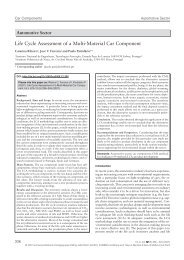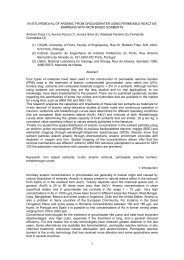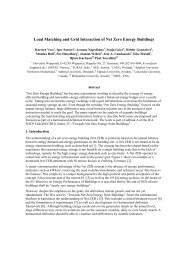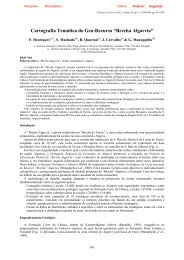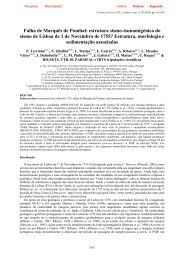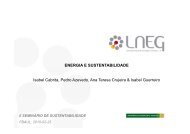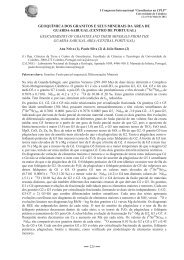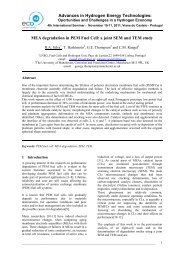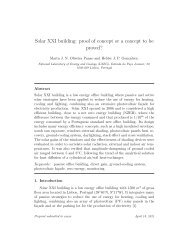On-demand hydrogen generation by hydrolysis of sodium ...
On-demand hydrogen generation by hydrolysis of sodium ...
On-demand hydrogen generation by hydrolysis of sodium ...
Create successful ePaper yourself
Turn your PDF publications into a flip-book with our unique Google optimized e-Paper software.
3º Seminário Internacional Torres Vedras (Portugal) April 29-30, 2010<br />
Hydrogen Energy and Sustainability- Advances in Fuel Cells and Hydrogen Workshop<br />
<strong>On</strong>-<strong>demand</strong> <strong>hydrogen</strong> <strong>generation</strong> <strong>by</strong> <strong>hydrolysis</strong> <strong>of</strong> <strong>sodium</strong> borohydride<br />
in batch reactors: effect <strong>of</strong> the buffer pressure<br />
M.J.F. Ferreira 1 , F. Coelho 1 , V.R.Fernandes 2 , C.M. Rangel 2 and A.M.F.R. Pinto 1<br />
1 Centro de Estudos de Fenómenos de Transporte - CEFT, Departamento de Engenharia Química , Faculdade de<br />
Engenharia da Universidade do Porto, Rua Dr. Roberto Frias s/n, 4200-465 Porto, Portugal<br />
emails: fermjf@fe.up.pt (M.J.F. Ferreira); eq07053@fe.up.pt (F. Coelho); apinto@fe.up.pt (A.M.F.R. Pinto)<br />
2 Laboratório Nacional de Energia e Geologia – LNEG, Fuel Cell and Hydrogen Unit,<br />
Estrada do Paço do Lumiar 22, 1649-038 Lisboa, Portugal<br />
emails: vitor.fernandes@leneg.pt; carmen.rangel@lneg.pt<br />
Abstract<br />
A study was undertaken in order to investigate the potential <strong>of</strong> <strong>hydrogen</strong> <strong>generation</strong> <strong>by</strong> <strong>hydrolysis</strong> <strong>of</strong> <strong>sodium</strong><br />
borohydride in batch reactors, operating at moderate pressures, in the presence <strong>of</strong> a reused nickel-ruthenium<br />
based catalyst, to feed on-<strong>demand</strong> a proton exchange membrane fuel cell. The effect <strong>of</strong> the buffer pressure is<br />
explored and <strong>hydrogen</strong> <strong>generation</strong> rates are evaluated <strong>by</strong> changing catalyst amount, operating pressure and<br />
successive refueling.<br />
Keywords: <strong>hydrogen</strong> <strong>generation</strong>, NaBH 4 , PEM fuel cell, Ni-Ru based catalyst, batch reactor, buffer pressure<br />
1 Introduction<br />
Our planet faces serious and unprecedented energy<br />
challenges relating to sustainability and greenhouse<br />
gas emissions as well as energy security. Policies<br />
supporting the use <strong>of</strong> renewable energy sources are<br />
making manufacture and supply <strong>of</strong> renewable<br />
energy technologies more attractive as business<br />
opportunities. In recent years, the increasing<br />
<strong>demand</strong> for more portable electronic equipments<br />
leads to rapid developing <strong>of</strong> proton exchange<br />
membrane (PEM) fuel cells. PEM fuel cell is suited<br />
for pure <strong>hydrogen</strong> (H 2 ) fuel and it is primarily<br />
aimed at the telecommunication market and the<br />
transport market. In truth, the performance <strong>of</strong> PEM<br />
fuel cell dominantly depends on the stable supply<br />
<strong>of</strong> high purity H 2 . Nevertheless, the methods <strong>of</strong><br />
storing <strong>hydrogen</strong> using tanks, activated carbon or<br />
nanoscale materials cannot keep the long-term<br />
<strong>hydrogen</strong> storage. At present, the borohydrides<br />
have been proved as the new stable <strong>hydrogen</strong>storage<br />
materials. High purity H 2 can be produced<br />
in the self-<strong>hydrolysis</strong> <strong>of</strong> the borohydrides. Among<br />
them, alkaline <strong>sodium</strong> borohydride (NaBH 4 )<br />
solution is attracting more attention because it has<br />
many advantages, including high theoretical<br />
<strong>hydrogen</strong> content (10.6 wt%), stable self-<strong>hydrolysis</strong><br />
process and friendliness to the environment. NaBH 4<br />
reacts with water to generate molecular <strong>hydrogen</strong><br />
according to the <strong>hydrolysis</strong> reaction:<br />
catalyst<br />
NaBH 4 + (2+x)H 2 O → NaBO 2 .xH 2 O + 4H 2 + heat, (1)<br />
where x is the hydration factor. Schlesinger et al.[1]<br />
recognized the particular striking catalytic effect <strong>of</strong><br />
certain transition metals and their salts on NaBH 4<br />
<strong>hydrolysis</strong> rate. Ideal <strong>hydrolysis</strong> is attained for x = 0<br />
[1], but in practice excess <strong>of</strong> water is required to<br />
account for the fact that the solid <strong>by</strong>-product<br />
(NaBO 2 .xH 2 O) can exist with varying degrees <strong>of</strong><br />
hydration [2]. At room temperature, however, the<br />
H 2 <strong>generation</strong> rate is not satisfactory without the<br />
presence <strong>of</strong> some catalysts. Several metal catalysts<br />
enhance <strong>hydrolysis</strong> <strong>of</strong> the alkaline NaBH 4 solution,<br />
giving high-performance H 2 <strong>generation</strong> rates.<br />
Demirci et al. [3] and more recently Liu et al. [4]<br />
reviewed the most used catalysts in reaction (1).<br />
The present work investigates the possibility <strong>of</strong><br />
simultaneously producing and storage H 2 to feed a<br />
PEM fuel cell, <strong>by</strong> using two batch reactors with<br />
different internal volumes, in the presence <strong>of</strong><br />
nickel–based bimetallic catalyst, reused 235-238<br />
times. The scenario <strong>of</strong> a sudden <strong>hydrogen</strong> on<strong>demand</strong><br />
is explored, <strong>by</strong> the quick opening reactor<br />
release valve (fixed on the outside lid <strong>of</strong> the<br />
reactor) for a few seconds, before reaction<br />
________________________________________________________________________ 24
3º Seminário Internacional Torres Vedras (Portugal) April 29-30, 2010<br />
Hydrogen Energy and Sustainability- Advances in Fuel Cells and Hydrogen Workshop<br />
completion. After then, the same valve is closed,<br />
and the <strong>hydrolysis</strong> reaction proceeds until its end.<br />
With this procedure, it is expected to accurately<br />
measure the H 2 <strong>generation</strong> rate, before and after the<br />
valve opening, and hence, studying the influence <strong>of</strong><br />
an unexpected interruption on normal H 2 <strong>generation</strong><br />
speeds. The effects <strong>of</strong> catalyst amount, operating<br />
pressure and successive refuelling on H 2 <strong>generation</strong><br />
rate with one swift interruption, are also<br />
investigated. As the authors are aware, the subject<br />
<strong>hydrogen</strong> buffer pressure on <strong>hydrogen</strong> production<br />
(and storage) <strong>by</strong> catalytic <strong>hydrolysis</strong> <strong>of</strong> NaBH 4 in<br />
batch reactors is for the first time exposed on the<br />
present paper. Actuality, the need <strong>of</strong> knowledge <strong>of</strong><br />
the working <strong>hydrogen</strong> buffer pressure can shed new<br />
ways <strong>of</strong> constructing <strong>hydrogen</strong> generators and even<br />
containers and also improve control/safety <strong>of</strong> these<br />
systems for several applications.<br />
2 Experimental procedure<br />
2.1. Catalyst reutilization between 235-238 times<br />
A nickel-based bimetallic catalyst <strong>of</strong> Ni-Ru, in the<br />
form <strong>of</strong> a finely divided powder and unsupported,<br />
was prepared in April <strong>of</strong> 2008 from a mixture <strong>of</strong><br />
precursors, based on nickel salts (Riedel-de Haën),<br />
<strong>by</strong> chemical reaction with 10 wt% borohydride<br />
solution (Rohm and Haas) as the reducing<br />
environment. The catalyst, characterized <strong>by</strong> a large<br />
specific surface area, has been used since synthesis<br />
in many studies [5-6]. Aiming at studying the<br />
recyclability and aging <strong>of</strong> the catalyst – it is still<br />
running at the present work - the experiments<br />
reported in the current paper were performed with<br />
the catalyst reused between 235-238 times.<br />
Weighted amounts <strong>of</strong> catalyst in the proportion <strong>of</strong><br />
Ni–Ru based catalyst/NaBH 4 : 0.4 and 0.6 g/g (or<br />
4.2 and 6.2 wt% <strong>of</strong> catalyst) were selected to study<br />
the influence <strong>of</strong> the amount <strong>of</strong> catalyst on H 2<br />
<strong>generation</strong> rate, before and after one swift<br />
interruption in the gas cumulative production.<br />
2.2. Hydrogen <strong>generation</strong> tests<br />
A volume <strong>of</strong> 10 cm 3 <strong>of</strong> stabilized <strong>sodium</strong><br />
borohydride aqueous solutions (10 wt% NaBH 4<br />
with 7 wt% NaOH) was injected into one <strong>of</strong> the two<br />
tested batch reactors – with internal volume <strong>of</strong><br />
0.646 L and 0.229 L (see Fig.1) – <strong>by</strong> means <strong>of</strong> a<br />
syringe.<br />
More specific details <strong>of</strong> experimental rig and<br />
procedure are explained on earlier works [5, 7]. All<br />
experiments were performed at room temperature<br />
(19.5-22 ºC) and without stirring. The temperature<br />
<strong>of</strong> the reactor medium was observed <strong>by</strong> a k-<br />
thermocouple and recorded simultaneously with a<br />
data acquisition system using LabView s<strong>of</strong>tware.<br />
To monitor the rate <strong>of</strong> <strong>hydrogen</strong> <strong>generation</strong>, the gas<br />
pressure inside the reactor was followed with an<br />
appropriate pressure probe.<br />
Thermocouple<br />
Internal volume<br />
646 cm 3<br />
Thermocouple<br />
Internal volume<br />
229 cm 3<br />
________________________________________________________________________ 25<br />
(a)<br />
Fig. 1. Schematic view <strong>of</strong> the inside <strong>of</strong> the two batch<br />
reactors: (a) reactor LR/0.646 L and (b) reactor SR/0.229<br />
L, with flat and conical bottom shapes, respectively.<br />
The <strong>hydrogen</strong> yield in reaction (1) was calculated<br />
<strong>by</strong> the following equation<br />
(b)<br />
yield (H = , (2)<br />
2<br />
) n(H<br />
2<br />
)<br />
exp<br />
/ n(H<br />
2<br />
)<br />
theoretical<br />
where n(H 2 ) exp is the total number <strong>of</strong> moles <strong>of</strong><br />
generated H 2 (before and during the reactor release<br />
valve opening and also after valve closing untill<br />
<strong>hydrolysis</strong> completion) and n(H 2 ) theoretical is the<br />
theoretical amount <strong>of</strong> generated H 2 assuming 100%<br />
conversion <strong>of</strong> NaBH 4 <strong>by</strong> applying the ideal gas law.<br />
Special care was taken to correct the free varying<br />
volume <strong>of</strong> gas inside the reactor due to the<br />
consumption <strong>of</strong> NaBH 4 and water [5].<br />
3 Results and discussion<br />
As already referred, <strong>hydrogen</strong> was generated from<br />
catalyzed <strong>hydrolysis</strong> <strong>of</strong> 10 cm 3 <strong>of</strong> the reactant<br />
solution (10 wt% NaBH 4 , 7 wt% NaOH, 83 wt%<br />
H 2 O) with Ni–Ru based catalyst/NaBH 4 : 0.4 and<br />
0.6 g/g. The effects <strong>of</strong> catalyst amount, system<br />
pressure and <strong>of</strong> two successive loadings <strong>of</strong> fuel on<br />
the <strong>hydrogen</strong> <strong>generation</strong> rate with one single<br />
sudden interruption (<strong>of</strong> a few seconds before<br />
reaction completion) were studied, and the results<br />
found are next presented and discussed.<br />
3.1. Effect <strong>of</strong> catalyst amount on <strong>hydrogen</strong> rate<br />
Figure 2 shows the influence <strong>of</strong> the amount <strong>of</strong><br />
catalyst used in H 2 <strong>generation</strong> rate performed in<br />
batch reactor LR (646 cm 3 ). As can be seen in the<br />
plot <strong>of</strong> Fig. 2, increasing the amount <strong>of</strong> the catalyst<br />
(catalyst/ NaBH 4 : 0.4 g/g to 0.6 g/g) increases the<br />
dP/dt slope in the linear zone. Hence, in Fig.2(a),<br />
for catalyst/ NaBH 4 : 0.4 g/g, the values <strong>of</strong> 0.004<br />
bar/s or 0.3 L(H 2 ) min -1 gcat -1 before sudden valve<br />
opening and <strong>of</strong> 0.005 bar/s or 0.4 L(H 2 ) min -1 gcat -1<br />
after valve closing till completion, were found. The<br />
same trend for one swift interruption was verified<br />
for the amount catalyst/ NaBH 4 : 0.6 g/g, but with
3º Seminário Internacional Torres Vedras (Portugal) April 29-30, 2010<br />
Hydrogen Energy and Sustainability- Advances in Fuel Cells and Hydrogen Workshop<br />
higher values in H 2 rates: 0.011 bar/s or 0.6 L(H 2 )<br />
min -1 gcat -1 before sudden valve opening and 0.006<br />
bar/s or 0.3 L(H 2 ) min -1 gcat -1 after valve closing to<br />
reaction completion.<br />
Pressure / bar<br />
Pressure / bar<br />
3<br />
2<br />
1<br />
0<br />
3<br />
2<br />
1<br />
0<br />
0 500 1000 1500<br />
I<br />
II<br />
I<br />
II<br />
Time / sec<br />
(a)<br />
sudden valve opening<br />
sudden valve opening<br />
0 500 1000 1500<br />
Time / sec<br />
25<br />
20<br />
15<br />
10<br />
5<br />
0<br />
25<br />
20<br />
15<br />
10<br />
5<br />
0<br />
Temperature / ºC<br />
Temperature / ºC<br />
(b)<br />
Fig. 2. Influence <strong>of</strong> the amount <strong>of</strong> catalyst on H 2<br />
<strong>generation</strong> rate with one swift interruption performed in<br />
batch reactor LR (646 cm 3 ): (a) catalyst/NaBH 4 : 0.4 g/g<br />
and (b) catalyst/NaBH 4 : 0.6 g/g.<br />
The plot in Fig.2(a), for a single fuel injection, also<br />
show the tendency <strong>of</strong> the studied system to<br />
maintain practically constant the H 2 <strong>generation</strong> rate<br />
before and after one swift interruption. These rates<br />
differs <strong>by</strong> a factor <strong>of</strong> 2 in case <strong>of</strong> the experiment<br />
with catalyst/NaBH 4 =0.6 g/g. In fact, in the plot <strong>of</strong><br />
Fig.2(b), after valve closing, the H 2 <strong>generation</strong> rate<br />
decreases gradually from 0.6 L(H 2 ) min -1 gcat -1 to<br />
0.3 L(H 2 ) min -1 gcat -1 . This may be caused <strong>by</strong> some<br />
H 2 adsorption at the surface <strong>of</strong> the porous catalyst<br />
(due to its higher amount in the system) and thus<br />
reducing its catalytic reactivity.<br />
3.2. Effect <strong>of</strong> pressure on H 2 <strong>generation</strong> rate<br />
Figure 3 shows the rate <strong>of</strong> <strong>hydrogen</strong> <strong>generation</strong> in<br />
terms <strong>of</strong> H 2 pressure as a function <strong>of</strong> time, for one<br />
single injection <strong>of</strong> 10 cm 3 <strong>of</strong> reactant solution,<br />
performed in the batch reactors LR and SR<br />
(Fig.3(a) and Fig.3(b), respectively), using a<br />
proportion Ni–Ru based catalyst/NaBH 4 : 0.4 g/g.<br />
________________________________________________________________________ 26<br />
Pressure / bar<br />
Pressure / bar<br />
3<br />
2<br />
1<br />
0<br />
3<br />
2<br />
1<br />
0<br />
0 200 400 600 800 1000<br />
I<br />
Time / sec<br />
(a)<br />
I<br />
II<br />
sudden valve opening<br />
0 200 400 600 800 1000<br />
Time / sec<br />
II<br />
sudden valve opening<br />
25<br />
20<br />
15<br />
10<br />
5<br />
0<br />
25<br />
20<br />
15<br />
10<br />
5<br />
0<br />
Temperature / ºC<br />
Temperature / ºC<br />
(b)<br />
Fig. 3. Influence <strong>of</strong> pressure on H 2 <strong>generation</strong> rate for<br />
one swift interruption performed in the: (a) batch reactor<br />
LR (646 cm 3 ) and (b) batch reactor SR (229 cm 3 ), with a<br />
proportion <strong>of</strong> Ni-Ru based catalyst/NaBH 4 : 0.4 g/g.<br />
As can be seen from the plots <strong>of</strong> Fig. 3 the effect <strong>of</strong><br />
pressure on H 2 rates is considerable. In truth, we<br />
may conclude that increasing the pressure, <strong>by</strong><br />
changing the reactor vessel from LR to SR,<br />
significantly increases H 2 rates from ∼0.0045 bar/s<br />
to ∼0.0085 bar/s.<br />
As expected, the H 2 rates or the dP/dt slopes in the<br />
linear zone <strong>of</strong> the plots outlined in Fig.3, remain<br />
almost constant before sudden valve opening and<br />
after closing it (∼0.3 L(H 2 ) min -1 gcat -1 ). However,<br />
looking at the end <strong>of</strong> the reaction curve, after the<br />
reactor release valve was closed, i.e., before H 2<br />
<strong>generation</strong> curve reaches the “plateau” (∼100%<br />
conversion), the aspect <strong>of</strong> the curves in that specific<br />
zone are quite different. In Fig.3(b), for the batch<br />
reactor SR with 229 cm 3 , a sharp edge was found.<br />
In its place, a round edge was sketch for the same<br />
experiment performed in reactor LR (with 646<br />
cm 3 ). A possible explanation could be related to the<br />
fact <strong>of</strong> the two batch reactors having different<br />
bottom geometries: the SR reactor has a conical<br />
bottom shape, which enhances the contact between<br />
the catalyst and the reactant solution [6]. The LR<br />
batch reactor has a flat bottom shape, which could<br />
rise to some mass transfer limitations between the<br />
reacting solution and the <strong>by</strong>-products.
3º Seminário Internacional Torres Vedras (Portugal) April 29-30, 2010<br />
Hydrogen Energy and Sustainability- Advances in Fuel Cells and Hydrogen Workshop<br />
It is worth to notice that the results presented in<br />
Figs.2-3 were achieved using Ni–Ru based<br />
powdered catalyst reused about 235-237 times.<br />
After separation from the reaction medium and<br />
rinsing with deionised water, the used Ni-Ru based<br />
catalyst was re-evaluated and almost the same<br />
catalytic activities were obtained during the studied<br />
cycles (for reproducibility).<br />
3.3. Effect <strong>of</strong> two successive loadings <strong>of</strong> reactant<br />
solution on <strong>hydrogen</strong> <strong>generation</strong> rate<br />
Figure 4 shows the <strong>hydrogen</strong> <strong>generation</strong> rates <strong>of</strong><br />
two successive loadings <strong>of</strong> 10 cm 3 <strong>of</strong> reactant<br />
solution, using a proportion Ni–Ru based<br />
catalyst/NaBH 4 = 0.6 g/g.<br />
Pressure / bar<br />
Pressure / bar<br />
3<br />
2<br />
1<br />
0<br />
3<br />
2<br />
1<br />
0<br />
I<br />
II<br />
0 500 1000 1500<br />
Time / sec<br />
I<br />
sudden valve opening<br />
(a)<br />
0 500 1000 1500<br />
Time / sec<br />
II<br />
sudden valve opening<br />
25<br />
20<br />
15<br />
10<br />
5<br />
0<br />
25<br />
20<br />
15<br />
10<br />
5<br />
0<br />
Temperature / ºC<br />
Temperature / ºC<br />
(b)<br />
Fig. 4. Hydrogen <strong>generation</strong> in batch reactor LR (646<br />
cm 3 ) <strong>of</strong> two successive loadings <strong>of</strong> 10 cm 3 <strong>of</strong> reactant<br />
solution, with Ni-Ru based catalyst/NaBH 4 = 0.6 g/g: (a)<br />
1 st loading and (b) 2 nd loading (performed after 15 days).<br />
The plots in Fig.4 show that the tendency to keep<br />
almost constant the <strong>hydrogen</strong> <strong>generation</strong> rates,<br />
before and after one swift interruption, differs from the<br />
experiments performed <strong>by</strong> one single loading (see<br />
Figs.2-3). With two successive refuellings, and for<br />
the same reactor bottom geometry, a reduction <strong>by</strong><br />
an half <strong>of</strong> H 2 <strong>generation</strong> rate value were observed,<br />
not only before and after the sudden H 2 release but<br />
also between the two successive loadings. Hence, in<br />
Fig.4(a), values <strong>of</strong> 0.6 L(H 2 ) min -1 gcat -1 before<br />
sudden valve opening and 0.3 L(H 2 ) min -1 gcat -1<br />
after valve closing (till completion) were attained.<br />
In Fig.4(b), 0.2 L(H 2 ) min -1 gcat -1 and 0.1 L(H 2 )<br />
min -1 gcat -1 were, respectively, found. It can be<br />
conclude that the effect <strong>of</strong> refuelling on H 2<br />
<strong>generation</strong> rates put forward the importance <strong>of</strong><br />
considering diffusion limitations between the fresh<br />
reacting solution and the remaining reused catalyst,<br />
which was kept at the bottom <strong>of</strong> the reaction vessel.<br />
4 Conclusions<br />
The <strong>hydrogen</strong> <strong>generation</strong> rates found in present<br />
studies are within the range <strong>of</strong> values reported in<br />
the open literature [3, 4], for catalyst metals with<br />
ruthenium. The need <strong>of</strong> defining a <strong>hydrogen</strong> buffer<br />
pressure, for example, to satisfy a sudden <strong>hydrogen</strong><br />
<strong>demand</strong>, was explored. To achieve this goal, the<br />
reactor release valve (fixed on the outside lid <strong>of</strong> the<br />
reactor) was quickly opened for a few seconds.<br />
Then after, the valve was closed and the H 2<br />
<strong>generation</strong> continues until <strong>hydrolysis</strong> completion.<br />
The results have shown the tendency <strong>of</strong> the studied<br />
systems to maintain constant the H 2 <strong>generation</strong><br />
rates for single fuel injections. This trend is broken<br />
in the experiments with successive refuelling,<br />
probably due to mass transfer limitations. To<br />
conclude, the analysis reported on the present paper<br />
provides a framework for predicting the<br />
performance <strong>of</strong> a reused powdered catalyst on H 2<br />
<strong>generation</strong> rate via <strong>hydrolysis</strong> <strong>of</strong> NaBH 4 in batch<br />
reactors for on-<strong>demand</strong> portable fuel cell<br />
applications.<br />
References<br />
[1] Schlesinger, HI, Brown, HC, Finholt, AE,<br />
Gilbreath, JR, Hoeskstra, HE and Hyde, K.. J. Am.<br />
Chem. Soc., Vol.75, 1953, pp. 215–219.<br />
[2] Marrero-Alfonso, E, Gray, JR, Davis, TA and<br />
Matthews, MA. Int. J. Hydrogen Energy, Vol.32,<br />
2007, pp. 4717–4722.<br />
[3] Demirci UB and Garin F. J Alloys Compd., Vol.<br />
463, 2008, pp.107–111.<br />
[4] Liu BH and Li ZP. J Power Sources, Vol. 187,<br />
2009, pp.527–534.<br />
[5] Ferreira, MJF, Fernandes, VR, Rangel, CM,<br />
Gales, L and Pinto, AMFR. J. <strong>of</strong> New Materials for<br />
Electrochemical Systems, Vol. 12, 2009, pp. 153-<br />
159.<br />
[6] Ferreira, M.F, Gales, L, Fernandes, VR, Rangel,<br />
CM and Pinto, AMFR. Int. J. Hydrogen Energy,<br />
2010, doi:10.1016/j.ijhydene.2010.02.121.<br />
[7] Pinto, AMFR, Falcão, DS, Silva, RA and<br />
Rangel, CM. Int. J. <strong>of</strong> Hydrogen Energy, Vol.31,<br />
2006, pp. 1341-1347.<br />
________________________________________________________________________ 27




